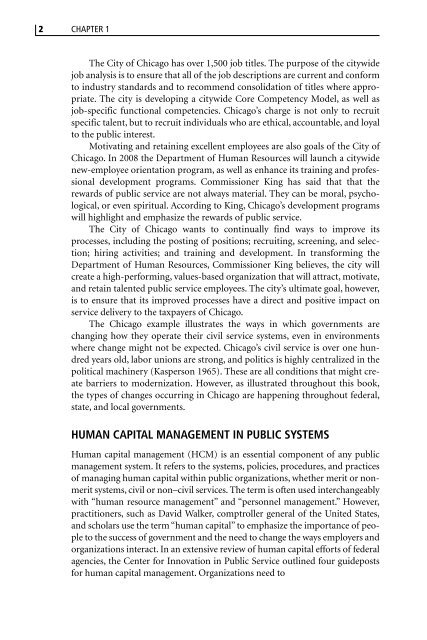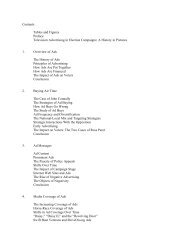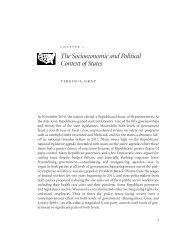Introduction to Human Capital Management in Public ... - CQ Press
Introduction to Human Capital Management in Public ... - CQ Press
Introduction to Human Capital Management in Public ... - CQ Press
Create successful ePaper yourself
Turn your PDF publications into a flip-book with our unique Google optimized e-Paper software.
010 Selden Ch01 (1-12).qxd 4/29/08 12:59 PM Page 2<br />
2 CHAPTER 1<br />
The City of Chicago has over 1,500 job titles. The purpose of the citywide<br />
job analysis is <strong>to</strong> ensure that all of the job descriptions are current and conform<br />
<strong>to</strong> <strong>in</strong>dustry standards and <strong>to</strong> recommend consolidation of titles where appropriate.<br />
The city is develop<strong>in</strong>g a citywide Core Competency Model, as well as<br />
job-specific functional competencies. Chicago’s charge is not only <strong>to</strong> recruit<br />
specific talent, but <strong>to</strong> recruit <strong>in</strong>dividuals who are ethical, accountable, and loyal<br />
<strong>to</strong> the public <strong>in</strong>terest.<br />
Motivat<strong>in</strong>g and reta<strong>in</strong><strong>in</strong>g excellent employees are also goals of the City of<br />
Chicago. In 2008 the Department of <strong>Human</strong> Resources will launch a citywide<br />
new-employee orientation program, as well as enhance its tra<strong>in</strong><strong>in</strong>g and professional<br />
development programs. Commissioner K<strong>in</strong>g has said that that the<br />
rewards of public service are not always material. They can be moral, psychological,<br />
or even spiritual. Accord<strong>in</strong>g <strong>to</strong> K<strong>in</strong>g, Chicago’s development programs<br />
will highlight and emphasize the rewards of public service.<br />
The City of Chicago wants <strong>to</strong> cont<strong>in</strong>ually f<strong>in</strong>d ways <strong>to</strong> improve its<br />
processes, <strong>in</strong>clud<strong>in</strong>g the post<strong>in</strong>g of positions; recruit<strong>in</strong>g, screen<strong>in</strong>g, and selection;<br />
hir<strong>in</strong>g activities; and tra<strong>in</strong><strong>in</strong>g and development. In transform<strong>in</strong>g the<br />
Department of <strong>Human</strong> Resources, Commissioner K<strong>in</strong>g believes, the city will<br />
create a high-perform<strong>in</strong>g, values-based organization that will attract, motivate,<br />
and reta<strong>in</strong> talented public service employees. The city’s ultimate goal, however,<br />
is <strong>to</strong> ensure that its improved processes have a direct and positive impact on<br />
service delivery <strong>to</strong> the taxpayers of Chicago.<br />
The Chicago example illustrates the ways <strong>in</strong> which governments are<br />
chang<strong>in</strong>g how they operate their civil service systems, even <strong>in</strong> environments<br />
where change might not be expected. Chicago’s civil service is over one hundred<br />
years old, labor unions are strong, and politics is highly centralized <strong>in</strong> the<br />
political mach<strong>in</strong>ery (Kasperson 1965). These are all conditions that might create<br />
barriers <strong>to</strong> modernization. However, as illustrated throughout this book,<br />
the types of changes occurr<strong>in</strong>g <strong>in</strong> Chicago are happen<strong>in</strong>g throughout federal,<br />
state, and local governments.<br />
HUMAN CAPITAL MANAGEMENT IN PUBLIC SYSTEMS<br />
<strong>Human</strong> capital management (HCM) is an essential component of any public<br />
management system. It refers <strong>to</strong> the systems, policies, procedures, and practices<br />
of manag<strong>in</strong>g human capital with<strong>in</strong> public organizations, whether merit or nonmerit<br />
systems, civil or non–civil services. The term is often used <strong>in</strong>terchangeably<br />
with “human resource management” and “personnel management.” However,<br />
practitioners, such as David Walker, comptroller general of the United States,<br />
and scholars use the term “human capital” <strong>to</strong> emphasize the importance of people<br />
<strong>to</strong> the success of government and the need <strong>to</strong> change the ways employers and<br />
organizations <strong>in</strong>teract. In an extensive review of human capital efforts of federal<br />
agencies, the Center for Innovation <strong>in</strong> <strong>Public</strong> Service outl<strong>in</strong>ed four guideposts<br />
for human capital management. Organizations need <strong>to</strong>









